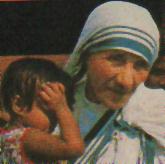Heroes of the Faith
Concise stories of significant Christian leaders
Concise stories of significant Christian leaders

 Mother Teresa
Mother Teresa1910-
Agnes Gonxha Bojaxhiu was born in August 1910 to well-to-do Albanian parents in Skopje, now within Yugoslavia. A deeply religious person and wanting to help the poor, at the age of 18 she went to the Sisters of Loreto Abbey in Dublin, where she studied English. That same year, 1928, she was sent to Darjeeling in the Himalayan foothills to begin her novitiate. By 1931, she was at a Loreto Convent School in Calcutta as teacher and later as principal.
On the other side of the concrete wall which guarded Loreto's green lawns and uniformed schoolgirls, is the Moti Jheel slum of mud lanes and wretched hovels. Sister Teresa's room overlooked the slum. She saw the dirt, the ragged children. the open sewers, the disease, the hunger in a city that was and is one giant quagmire of pestilence, poverty and famine. After school she would often go among the slum-dwellers, bringing them medicine and bandages.
She was on a train to Darjeeling in 1946 when she heard her second call - it was "quite clear. I was to leave the convent and help the poor while living among them. It was an order."
She was then just an obscure nun with a powerful will, and it took her two years to get through a sceptical Indian Roman Catholic hierarchy and win permission to be a "free" nun outside the cloister. She took intensive if rudimentary medical training at Patna, in north-eastern India, and returned to the slums of Calcutta.
Her first school was a bare patch of ground, where she drew Bengali letters on the earth with a stick. for five or six children. The slum families took notice, and some tables appeared, then benches and a blackboard. And more children. We see here an important pattern which has continued over the years. Mother Teresa sees a basic need, and begins to address that need directly with what there is. The people who are assisted, then the wider community, see the good that is happening and help.
Sister Teresa was joined in Calcutta in March 1949 by former student from Loreto, Subashini Das, 19, who took the name Agnes. She is still Number Two in the Missionaries of Charity. Then others came. They lived on the top floor of a large house offered by a Bengali Christian. They begged for food and medicines for the poor, for spare land and shacks for dispensaries and schools.
The Order formally began in October 1950. Sister Teresa, by now an Indian citizen, became Mother Teresa. While other Christian orders have been in decline, hers has surged ahead in members and in works on the simple principle that in serving the poorest they are serving God.
Mother Teresa has been criticised for failure to lead public crusades against the root causes of poverty, but says, "That's God's business. It's not my business. Someone once said to me, 'Why do you give them fish to eat? Why don't you give them a rod to catch the fish?' And I said, 'But my people can't even stand. They're sick, crippled, demented. When I have given them fish to eat and they can stand, I'll turn them over and you give them the rod to catch the fish!'"
Mother Teresa and her missionaries do teach by ex ample the one essential that, she says, God would have the world do about poverty. "The only thing that can remove poverty is sharing. Jesus came among the poorest, to teach people to love one another, which is to share to use the gifts that God has given to people who have, to share with those who have not."
"The poor," as Jesus said, "we always have with us" - and not just in India, but in every country the "hidden poor" must be sought out. There are 21 Missionaries of Charity houses in America, two in France, 133 in Italy . In Australia, the Order's 38 sisters dispense love and care from seven Missionaries of Charity houses - in Melbourne; in Bourke, Queanbeyan and Orange, New South Wales; and in Darwin, Katherine and Tennant Creek, Northern Territory. Much of their work is among Aboriginals, drug addicts and alcoholics. In Melbourne, Sister Magdalena, an Indian who is regional superior for Australia and New Guinea, says, "We go where there is the greatest need - and God points the way. Nothing is planned beyond making ourselves accessible to the poor."
Some of these countries would seem to have resources enough to care for their own poor. But Mother Teresa says, "There are hungry people everywhere. They have soup kitchens in New York, London, Canada. But poverty is not just being without food. It is the absence of love. I can tell you there is more warmth in Calcutta, where people are willing to share what there is, than in many places where they have everything.
"There are people who have no one. They may not be dying of hunger, for they are dying of hunger for love. Especially the drunkards, the drug addicts. We give them tender love and care. Often in big cities, big countries, people simply die of loneliness, unwanted, unloved, forgotten. This is a much more bitter poverty than the poverty not to have food."
How did one woman achieve world recognition, a 1979 Nobel peace prize, the founding of a religious order that, in less than 40 years, has soared from a membership of one to some 3000 sisters and 400 brothers? "It is God's work that has done it, not my work," she says, "because humanly speaking, it was not possible. He did it."